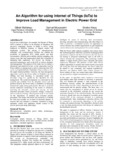Please use this identifier to cite or link to this item:
https://cris.library.msu.ac.zw//handle/11408/2997| Title: | An algorithm for using internet of things (IoTs) to improve load management in electric power grid | Authors: | Mahlangu, Gilbert Musungwini, Samuel Nleya, Sindiso |
Keywords: | Conceptual model Internet of Things (IoTs) Load management Electric, power grid Consumer priority |
Issue Date: | 2018 | Publisher: | Foundation of Computer Science | Series/Report no.: | International Journal of Computer Applications;Vol. 175, No. 39: p. 10-17 | Abstract: | Several new technologies, for example, the Internet of Things (IoTs) continue to surface in the frontage of ubiquitous and pervasive computing. Internet of things is slowly being embraced in different domains to support control and monitoring systems. The advent of microprocessors embedded with communication facilities has enabled the possibility of integrating ICTs within people and their environments. With the power utilities industry grappling with serious issues like load management which has a potential of damaging their equipment, first movers are turning to advanced technologies such as the IoTs to achieve demandside management. The purpose of this study was to conduct a theoretical and empirical review on the approaches used by Power utilities to manage load in order to determine how IoTs can be used particularly by Zimbabwe’s Power utility to solve the supply-demand problem. Currently, the load management approaches used by the Power utility in Zimbabwe are load shifting and load shedding. A conceptual model was developed using C++ guided by the algorithm for load management. The model development was motivated by the research gap establish from the literature review and the problem faced by the Power utility in Zimbabwe in balancing demand and supply during peak periods. The idea is modelled around continuous monitoring of the feeder or substation, activating the automatic control and carrying out load allocation procedure based on priority settings, connection, and re-connection timings. The proposed model is also based on the dependence of demand and consumer priority perception. The model will ensure that electricity is available for basic and essential use in times of increased demand. It requires that load demand is constantly monitored to trigger automatic control and appliances should connect to the electric power grid using smart plugs. | URI: | http://hdl.handle.net/11408/2997 | ISSN: | 0975-8887 |
| Appears in Collections: | Research Papers |
Files in This Item:
| File | Description | Size | Format | |
|---|---|---|---|---|
| Musungwini-2018.pdf | Full Text | 578.19 kB | Adobe PDF |  View/Open |
Page view(s)
98
checked on Feb 26, 2025
Download(s)
52
checked on Feb 26, 2025
Google ScholarTM
Check
Items in MSUIR are protected by copyright, with all rights reserved, unless otherwise indicated.


